[Saturn 土星中]土星是离太阳第六远的行星,也是九大行星中第二大的行星:公转轨道: 距太阳 1,429,400,000 千米 (9.54 天文单位)卫星直径: 120,536 千米 (赤道)质量: 5.68e26 千克在罗马神...+阅读
Saturn is the sixth pla from the Sun and the second largest:
orbit: 1,429,400,000 km (9.54 AU) from Sun
diameter: 120,536 km (equatorial)
mass: 5.68e26 kg
Hardcopy The New Solar System
Summarizes what we he learned from interplaary explorations in the last 25 years. My primary reference for The Nine Plas.
Encyclopedia of the Solar System
A more scholarly introduction the plaary science for those who want to dig a little deeper.
The pact NASA Atlas of the Solar System
This road map of the solar system contains lots of maps and data as well as photos. In Roman mythology, Saturn is the god of agriculture. The associated Greek god, Cronus, was the son of Uranus and Gaia and the father of Zeus (Jupiter). Saturn is the root of the English word "Saturday".
Saturn has been known since prehistoric times. Galileo was the first to observe it with a telescope in 1610; he noted its odd appearance but was confused by it. Early observations of Saturn were plicated by the fact that the Earth passes through the plane of Saturn's rings every few years as Saturn moves in its orbit. A low resolution image of Saturn therefore changes drastically. It was not until 1659 that Christiaan Huygens correctly inferred the geometry of the rings. Saturn's rings remained unique in the known solar system until 1977 when very faint rings were discovered around Uranus (and shortly thereafter around Jupiter and Neptune).
Saturn was first visited by NASA's Pioneer 11 in 1979 and later by Voyager 1 and Voyager 2. Cassini (a joint NASA / ESA project) arrived on July 1, 2004 and will orbit Saturn for at least four years.
Saturn is visibly flattened (oblate) when viewed through a small telescope; its equatorial and polar diameters vary by almost 10% (120,536 km vs. 108,728 km). This is the result of its rapid rotation and fluid state. The other gas plas are also oblate, but not so much so.
Saturn is the least dense of the plas; its specific grity (0.7) is less than that of water.
Like Jupiter, Saturn is about 75% hydrogen and 25% helium with traces of water, methane, ammonia and "rock", similar to the position of the primordial Solar Nebula from which the solar system was formed.
Saturn's interior is similar to Jupiter's consisting of a rocky core, a liquid metallic hydrogen layer and a molecular hydrogen layer. Traces of various ices are also present.
Saturn's interior is hot (12000 K at the core) and Saturn radiates more energy into space than it receives from the Sun. Most of the extra energy is generated by the Kelvin-Helmholtz mechanism as in Jupiter. But this may not be sufficient to explain Saturn's luminosity; some additional mechanism may be at work, perhaps the "raining out" of helium deep in Saturn's interior.
The bands so prominent on Jupiter are much fainter on Saturn. They are also much wider near the equator. Details in the cloud tops are invisible from Earth so it was not until the Voyager encounters that any detail of Saturn's atmospheric circulation could be studied. Saturn also exhibits long-lived ovals (red spot at center of image at right) and other features mon on Jupiter. In 1990, HST observed an enormous white cloud near Saturn's equator which was not present during the Voyager encounters; in 1994 another, smaller storm was observed.
Two prominent rings (A and B) and one faint ring (C) can be seen from the Earth. The gap between the A and B rings is known as the Cassini division. The much fainter gap in the outer part of the A ring is known as the Encke Division (but this is somewhat of a misnomer since it was very likely never seen by Encke). The Voyager pictures show four additional faint rings. Saturn's rings, unlike the rings of the other plas, are very bright (albedo 0.2 - 0.6).
Though they look continuous from the Earth, the rings are actually posed of innumerable small particles each in an independent orbit. They range in size from a centimeter or so to several meters. A few kilometer-sized objects are also likely.
Saturn's rings are extraordinarily thin: though they're 250,000 km or more in diameter they're less than one kilometer thick. Despite their impressive appearance, there's really very little material in the rings —— if the rings were pressed into a single body it would be no more than 100 km across.
The ring particles seem to be posed primarily of water ice, but they may also include rocky particles with icy coatings.
Voyager confir

med the existence of puzzling radial inhomogeneities in the rings called "spokes" which were first reported by amateur astronomers. Their nature remains a mystery, but may he something to do with Saturn's magic field.
Saturn's outermost ring, the F-ring, is a plex structure made up of several smaller rings along which "knots" are visible. Scientists speculate that the knots may be clumps of ring material, or mini moons. The strange braided appearance visible in the Voyager 1 images is not seen in the Voyager 2 images perhaps because Voyager 2 imaged regions where the ponent rings are roughly parallel. They are prominent in the Cassini images which also show some as yet unexplained wispy spiral structures.
There are plex tidal resonances between some of Saturn's moons and the ring system: some of the moons, the so-called "shepherding satellites" (i.e. Atlas, Prometheus and Pandora) are clearly important in keeping the rings in place; Mimas seems to be responsible for the paucity of material in the Cassini division, which seems to be similar to the Kirkwood gaps in the asteroid belt; Pan is located inside the Encke Division and S/2005 S1 is in the center of the Keeler Gap. The whole system is very plex and as yet poorly understood.
The origin of the rings of Saturn (and the other jovian plas) is unknown. Though they may he had rings since their formation, the ring systems are not stable and must be regenerated by ongoing processes, perhaps the breakup of larger satellites. The current set of rings may be only a few hundred million years old.
Like the other jovian plas, Saturn has a significant magic field.
When it is in the nighttime sky, Saturn is easily visible to the unaided eye. Though it is not nearly as bright as Jupiter, it is easy to identify as a pla because it doesn't "twinkle" like the stars do. The rings and the larger satellites are visible with a small astronomical telescope. There are several Web sites that show the current position of Saturn (and the other plas) in the sky. More detailed and customized charts can be created with a plaarium program.
Saturn's Satellites
Saturn has 34 named satellites:
Of those moons for which rotation rates are known, all but Phoebe and Hyperion rotate synchronously.
The three pairs Mimas-Tethys, Enceladus-Dione and Titan-Hyperion interact gritationally in such a way as to maintain stable relationships between their orbits: the period of Mimas' orbit is exactly half that of Tethys, they are thus said to be in a 1:2 resonance; Enceladus-Dione are also 1:2; Titan-Hyperion are in a 3:4 resonance.
Distance Radius Mass
Satellite (000 km) (km) (kg) Discoverer Date
--------- -------- ------ ------- ---------- -----
Pan 134 10 ? Showalter 1990
Atlas 138 14 ? Terrile 1980
Prometheus 139 46 2.70e17 Collins 1980
Pandora 142 46 2.20e17 Collins 1980
Epimetheus 151 57 5.60e17 Walker 1980
Janus 151 89 2.01e18 Dollfus 1966
Mimas 186 196 3.80e19 Herschel 1789
Enceladus 238 260 8.40e19 Herschel 1789
Tethys 295 530 7.55e20 Cassini 1684
Telesto 295 15 ? Reitsema 1980
Calypso 295 13 ? Pascu 1980
Dione 377 560 1.05e21 Cassini 1684
Helene 377 16 ? Laques 1980
Rhea 527 765 2.49e21 Cassini 1672
Titan 1222 2575 1.35e23 Huygens 1655
Hyperion 1481 143 1.77e19 Bond 1848
Iapetus 3561 730 1.88e21 Cassini 1671
Phoebe 12952 110 4.00e18 Pickering 1898
Saturn's Rings
Radius Radius approx. approx.
Name inner outer width position mass (kg)
---- ------ ------ ----- -------- --------
D-Ring 67,000 74,500 7,500 (ring)
Guerin Division
C-Ring 74,500 92,000 17,500 (ring) 1.1e18
Maxwell Division 87,500 88,000 500 (divide)
B-Ring 92,000 117,500 25,500 (ring) 2.8e19
Cassini Division 115,800 120,600 4,800 (divide)
Huygens Gap 117,680 (n/a) 285-440 (subdiv)
A-Ring 122,200 136,800 14,600 (ring) 6.2e18
Encke Minima 126,430 129,940 3,500 29%-53%
Encke Division 133,410 133,740
Keeler Gap 136,510 136,550
F-Ring 140,210 30-500 (ring)
G-Ring 165,800 173,800 8,000 (ring) 1e7?
E-Ring 180,000 480,000 300,000 (ring)
Notes:
* distance is kilometers from Saturn's center
* the "Encke Minima" is a slang term used by amateur astronomers, not an official IAU designation
This categorization is actually somewhat misleading as the density of particles varies in a plex way not indicated by a division into neat regions: there are variations within the rings; the gaps are not entirely empty; the rings are not perfectly circular.
以下为关联文档:
土星可能的新卫星这是一份未确认的被报告发现的土星卫星的暂定命名与公转半径表: 命名 距离 (千米) S/1981 S 7 S/1981 S 10 S/1981 S 11 S/1981 S 14 200000? S/1981 S 15 174000 S/1981 S 16...




